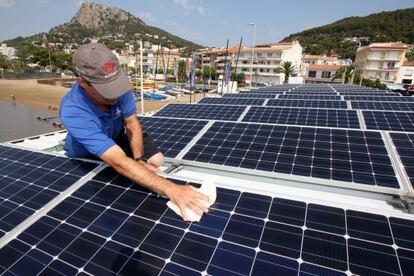Why the price of the sun is rising for home electricity producers
The latest energy reform is making self-generation more expensive

The possibility of generating electricity using renewable resources such as solar panels or small wind turbines at home is becoming an increasingly attractive proposition to Spanish households. "Of every 50 calls we get every month, 35 are from individuals who are interested in self-production," says Francesc Mateu, manager of Sol Gironés, a company specializing in renewable energy. "For now we are telling them that they have to wait until September or October, when things become clearer."
The growing tendency of utility companies to charge a higher fixed rate and lower rates for actual energy use, plus specific fees for self-production about to go into effect, work together to make generating your own electricity less attractive than traditional consumption.
The government has decided that home renewable energy systems must be introduced slowly and without altering the existing system. That is why it is reserving the right to raise or lower these specific fees depending on how the sector evolves.
Of all possible energy reform scenarios, this is the worst one"
"We are basically going to pay a levy for the energy we get from the sun," sums up Mario Sorinas of Electrobin, a firm with over 20 years' experience in solar energy.
Energy self-sufficiency is fairly well consolidated in countries such as the US and Japan. In Europe many countries have different formulas to regulate it. "This is the future," agree many energy experts. Home renewable energy systems allow people to generate their own power, giving the environment - and their pocketbooks - a break. There is also the option of transferring excess energy to the local power company and getting it back whenever necessary, or even selling it to the grid and turning a profit. But that is an option that the Spanish government is not even considering. The draft decree makes it clear there will be no profits to be made from any excess energy that reverts to the power grid.
Right now, it is possible to generate energy privately in Spain as long as it is used immediately - known as instantaneous self-consumption. The latest legislation on this option dates from 2011. Nobody did it before this because it wasn't worth it financially. But the cost of photovoltaic equipment has dropped as much as 80 percent in the last five years, while electricity bills have kept rising, making self-sufficiency an attractive option in these times of crisis. Cow farms use it, supermarkets use it, and even the odd private consumer uses it. Excess energy may not be stored in batteries as that is prohibited. When there is no sun or wind, consumers have to use the regular service and pay the bill.
There is no official register of individuals or firms that use renewable energy systems. The magazine Alimarket has counted 43 cases, while a voluntary list drawn up by users on website Energética 21 has 74 cases.
Sol Gironés, which employs 14 people, says the system is working well "especially for meat businesses and restaurants, both of which rely heavily on refrigerators, and pay at least 15 percent of their fixed annual costs on electricity." These renewable energy systems typically reduce consumption between 20 and 30 percent, though there was a case when the reduction reached 44 percent. Until now, this type of generation has been tax free.
The water sports center Club Naùtic Estartit, in Torroella de Montgrí (Girona), is one of Sol Gironés' clients. The club has designed a five-year plan to get renewable energy to account for 20 percent of its total consumption. For now, the solar panels are providing seven percent. "We are located near a natural park and we want to have the smallest possible impact on the environment," says club director Eugeni Figa.
In Galicia, the Domínguez brothers have been working with renewables since 1998. "There was just a handful of us doing this back then," Manuel explains. In 2007 they led by example, fitting their offices in Sanxenxo (Pontevedra) with a solar energy system. Although they have a few projects in Spain, most of their market is in large parks in Chile, Mexico, Romania and the UK.
The government's energy reform has greatly angered the renewables industry. "Of all possible scenarios, this is the worst one," says José Donoso, chairman of the Spanish Photovoltaic Union (Unef), which represents 85 percent of the sector. "They haven't approved anything specific yet on self-production but they've managed to kill it already."
Donoso is referring to the increase in the fixed portion of electricity costs, which is set to rise 77 percent for a regular household bill, and even self-producers cannot avoid paying it. Meanwhile, the variable portion of the bill, representing actual use, goes down 23 percent. This is the part that renewables can reduce.
"Until now, expenditure was around 30 percent of fixed costs and 70 percent of variable costs. We are moving toward a 50-50 balance, which makes any initiative aimed at generating your own energy less attractive," notes Ignacio Cruz, a researcher in the Renewable Energy division at the Center for Energy, Technology and Environmental Research (CIEMAT).
"This is a deadly blow to net balance and energy savings," says Javier García Breva, a consultant specializing in renewable energy and former director of the Institute for the Diversification and Saving of Energy (IDAE). He holds that these measures are aimed solely at getting power firms to make more money. Unesa, the association of major power companies, declined to assess self-production until the legal changes are clearer. The Industry Ministry also failed to return EL PAÍS's calls for information.
But the changes announced so far mean amortization periods for solar energy systems will become considerably longer. Before the reform, it took 12 years to amortize investment on a 2.4 kW home system; now, it will take 23 more years, according to Unef's calculations. But there are people working on that problem already. Sol Gironés says its clients are reducing the wattage they pay their utility for (the fixed part of the bill that is set to go up) because their home systems are already covering their energy needs. Another goal is to make home renewable energy systems profitable.
Tu suscripción se está usando en otro dispositivo
¿Quieres añadir otro usuario a tu suscripción?
Si continúas leyendo en este dispositivo, no se podrá leer en el otro.
FlechaTu suscripción se está usando en otro dispositivo y solo puedes acceder a EL PAÍS desde un dispositivo a la vez.
Si quieres compartir tu cuenta, cambia tu suscripción a la modalidad Premium, así podrás añadir otro usuario. Cada uno accederá con su propia cuenta de email, lo que os permitirá personalizar vuestra experiencia en EL PAÍS.
¿Tienes una suscripción de empresa? Accede aquí para contratar más cuentas.
En el caso de no saber quién está usando tu cuenta, te recomendamos cambiar tu contraseña aquí.
Si decides continuar compartiendo tu cuenta, este mensaje se mostrará en tu dispositivo y en el de la otra persona que está usando tu cuenta de forma indefinida, afectando a tu experiencia de lectura. Puedes consultar aquí los términos y condiciones de la suscripción digital.
Últimas noticias
Reinhard Genzel, Nobel laureate in physics: ‘One-minute videos will never give you the truth’
Pinochet’s victims grapple with José Antonio Kast’s rise in Chile
How Japan is trying to avert ‘digital defeat’
The complicated life of Francesca Albanese: A rising figure in Italy but barred from every bank by Trump’s sanctions
Most viewed
- Pablo Escobar’s hippos: A serious environmental problem, 40 years on
- Why we lost the habit of sleeping in two segments and how that changed our sense of time
- Charles Dubouloz, mountaineering star, retires at 36 with a farewell tour inspired by Walter Bonatti
- Trump’s obsession with putting his name on everything is unprecedented in the United States
- The Florida Keys tourist paradise is besieged by immigration agents: ‘We’ve never seen anything like this’









































